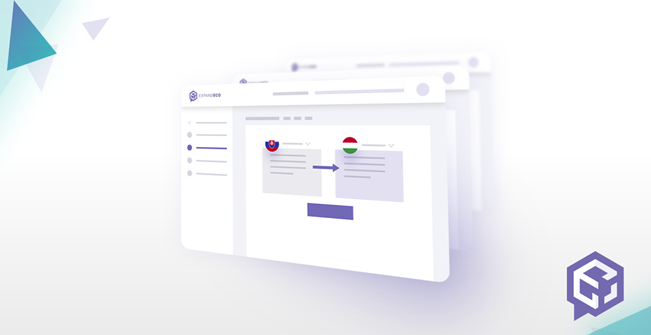Naturally, your website will be the first thing to be thoroughly addressed when entering a new market – fine tuned online content is the cornerstone of any e-commerce success, however, you may be surprised about what is hidden under the online shop localisation. We have prepared a complete list and a summary checklist for our newsletter subscribers.
Why should you localise your website?
Localising your website to a new market doesn't just mean translating it. When you do the localisation thoroughly and correctly, you are virtually indistinguishable from home-grown players. "Creating a website in a local language is one of the first steps if you are serious about expansion," explains Paweł Bilczyński, Expandeco’s Sales Manager for Poland. He adds: "Investing in quality will bring returns in how you are perceived in the country. Cheap translations can be grammatically and meaningfully correct, but without understanding the local customer – they may seem machine-translated, illogical, strange and full of sentences that potential customers would not say in such a way. If you want to look like a Polish (or any other) online shop, the customer must feel at home wherever the shop is located." So what should you look out for when translating your website?

1. A coherent domain and brand
Website localisation naturally starts with purchasing a local domain. If you have a unique and memorable name, this will be easier and such domains are usually available. Some entrepreneurs already have them purchased in advance for most EU countries, which allows them to keep expansion under a uniform name and brand. A problem may arise if the name of your online shop matches the focus in which you do business, such as NajlepsieObrazy.sk or TopObrazy.cz. (both web addresses mean "the best pictures" in the local name). Indeed: "Many of these generic domains are occupied, which in itself complicates expansion. At Expandeco, we recommend considering expansion under a uniform name," says Tomáš Vrtík, Managing Partner.
When you set up your online shop a few years ago, you did not think that one day your business would grow into new markets. "If that time wasn't five years ago, make it today. In terms of brand coherence and memorability, it is appropriate to communicate one name across markets. This will also facilitate your other marketing and graphic work," says Vrtík.
Here's a tip: if your name is "too local" and it will not make much sense in another country, consider switching that name into the local language. You will still maintain a unified brand. One example is Rohlik.cz and its Kifli.hu Hungarian offshoot – they kept the complete visual identity of a successful Czech brand.

2. A unique selling proposition (USP)
Reflection requires brand positioning during expansion. If you boast about having the densest branch network in your home country, and this is meant to be the main selling argument for your potential buyers, you can hardly take advantage in a new market. Instead, you should find reasons why locals in the new market should be buying from you instead of someone else; for example, Bibloo’s fashion online shop and concept store has the following advantage in seven European countries: "As a foreign player, we were able to compete with local online shops in the speed and quality of logistics, reverse logistics and customer care."
How can you create a unique selling proposition before expansion? If you do not have an internal person in the team, Vrtík advises you to find a partner in the given market who will create a connection – they will supply you with news from the market and act as a kind of newsfeed. "I strongly recommend travelling to the country – even for a month to find out how young people live and how your target audience lives, both in the city and on the periphery. Talk to people and make as many contacts as possible during your visit." You will understand the mentality of the people and you can be authentic in the new market – it will no longer be "foreign" to you. According to Vrtík, the aim of localisation is authenticity in the new market: "If you hear from the customer in communication or reviews something like: ‘Wow! You're from Slovakia, I didn't even know that. You have great service. Keep it up!’ – then that is the biggest reward for online shops."

3. Product portfolio
The third area you need to think about is adapting the product portfolio to the new country. Website localisation should therefore go hand in hand with (or be based on) market research. According to Vrtík, you should not take the same list of 20,000 products of whiteware – when expanding to Ukraine, for instance – only to find out that there is absolutely no interest in certain brands of washing machine or microwave and that the popular ones in the new market are brands which you would not even find a proper supplier for back home.
Selecting products for expansion is one of the most underrated steps. This is related to the preferences of each market, brand search and brand popularity. AEG washing machines appear four times in the top ten bestsellers in Slovakia (in the first, third, sixth and eighth places), whereas in Hungary it is only once (in ninth place) and not at all in Romania – the Arctic and Beko brands are the winners there. Or let us take another segment: acoustic guitars. In the Czech Republic and Hungary, the bestselling guitars comprise a wide range of manufacturers – there is a different brand for every place in the top ten. By contrast, in Romania we find guitars from just three manufacturers in the top ten: six Fenders, three Yamahas and one Ibanez.


When you start, it is good to enter the market with sought-after products.
According to Vrtík, there are two practical strategies. "When you start, it is good to enter the market with sought-after products. Find out which brands your portfolio buyers' market already contains, and appropriately adjust the offer of products on your website. You will then test how you are doing in the new country and you can gradually add more.”
"You can also expand with brands that are unknown in the market and where there is no competition in the given category; however, it is necessary to take into account the investment in brand awareness," adds Vrtík.
Here’s a tip: the location of the product portfolio (and product descriptions) must reflect local specificities. For example, for clothing and shoes, make sure that the country uses the size system common for continental Europe. Otherwise you will have to re-number the goods. A size conversion table is a solution for those who sell to a large number of markets.

4. Language, tone and terminology that is appropriate for the target group
You will then continue to deal with the text itself. You want it translated correctly, of course, but that is far from enough. Most online shops outsource translations. And this is logical – hardly anyone has bilingual members in the team who are also copywriters. Think clearly about your tone before the person or company you have selected starts translating. Who are your customers? What tone of voice does your brand have? Are you a seller of streetwear fashion? Can you address someone informally? In such cases, excessive sterility in the text would not fit the brand and would completely put off potential shoppers.


The biggest challenge of the whole website localisation was choosing a quality translator.
If you speak more formally, for example to the B2B scientific community, too much playfulness may be detrimental. You can get to know an experienced translation partner by asking them about it yourself: "The biggest challenge of the whole website localisation was choosing a quality translator. We did not make the right choice at first; the texts were translated by an older man. Our field is feminine and slang-based, which we use in Slovak, and it sounded awkward in translation," says David Peterek, the founder of the NaniNails online shop, in commenting on expansion to Romania.
How did he find out that the original texts were not well localised? "Ads that we had correctly targeted were not converted at all. Also, occasional feedback from customers helped us decipher where the problem was. Expandeco helped us to translate the texts correctly, and the negative feedback disappeared. We are still finding and ironing out kinks in the advertising campaigns. It is an ongoing process," says Peterek.

5. Keyword analysis and localisation, SEO and meta data
Sought-after terms may be different from domestic terms in the new market. Before switching all domestic keywords into another language, they need to be updated on the basis of a market survey. "I recommend doing keywords for each language separately to help yourself with logic from the mother tongue: what could people be looking for?" says Lukáš Pitre, a marketing consultant for e-commerce. He adds: "Every language has a different structure, a different grammar, different synonyms and different descriptive phrases, and this is mirrored in different ways of searching. This is essential to know for both on-page optimisation and campaign structure. Also, each market is at a different level of development. While in some places the topic is relatively new and the key expressions may fall flat, elsewhere the topic may resonate more and the question structure will be richer.”


Every language has a different structure, a different grammar, different synonyms and, different descriptive phrases, and this is mirrored in different ways of searching.
According to Vrtík, technical SEO can be set so that it is uniform across Europe: "In some places this will help, whereas in others it can easily hurt, but I'm an advocate of technical SEO being procured centrally." Off-page SEO – such as link building and other activities that yield better search rankings over the long term – requires regular work to keep up with local competition. Pitre adds that: "The media market and its practices (including the prices of collaboration) vary dramatically. What is prohibitively expensive in Western Europe may not even exist in the East." It is best to deal with a good freelancer or agency with local knowledge and the language skills to negotiate.
Meta data is also subject to localisation. "Whereas various superlatives or bargain discounts and special prices are popular with some countries, a German customer may perceive such communication as being from a street market and thus untrustworthy and cheap. They respond better to guarantees and signals of credibility and quality. Another country may prefer a national emphasis or conversely prefer foreign (Western) goods and services. Create meta data tailored to the market – either based on PPC tests or consumer research," says Pitre.
Here’s a tip: localisation also applies to URLs. Also make sure you have all pop-ups, error messages and automatic emails and SMSs localised as well.

6. The shopping basket: ordering, payment and delivery methods
How can you optimise the shopping experience to make your locals feel at home? Well, find out what their home looks like. "The search doesn't have to be difficult. Go to the largest local price comparison site and choose the best competitors in your segment – the ones with the most positive reviews. Then you simply click through, observe the common features of the shopping baskets and try to get as close to this state as possible," says Vrtík in describing a path that is available to everyone. "We can connect you to specialists in different countries who can prepare a customised shopping basket for you."
Pitre recommends studying in detail what consumers are used to and not forcing them to think unnecessarily: "This also refers to the visual hierarchy of information. To put it very simply: in Poland you will dazzle customers with visible savings and discounts; in Germany, on the contrary, you will do the same with unmistakable signs of quality and consumer confidence. Also, check your country's legal requirements: in Germany, for example, the functional elements of the shopping basket are required by law, which nobody in Poland would care about. Southern and Scandinavian countries have a different culture."
You may also be interested in the following:
- What are the most common delivery methods: post, courier, or various pickup points?
- Which courier companies are popular in the country?
- What percentage of shoppers pay by card, bank transfer or cash on delivery? How does this distribution change depending on demographics?
- Which payment gateways are most commonly used in the country?
Here’s a tip: on Expandeco’s website, you will find answers to every market that we can help you expand into. You just have to click on the map on our home page.
The shopping basket is not just about delivery and payment. Observe how the local competition addresses the ordering method. Do people usually have to register? Or can they purchase without doing so? "For the Romanian version of the online shop, we had to remove the postcode from the order form. In the Czech Republic and Slovakia, we have it as a compulsory entry. But Romanians do not know what a postcode is. It's a small thing, but an essential one,” says Peterek, who adds: "Once we uploaded the county and city guide, the number of orders increased."

7. A bank account
An ideal shopping basket location may not be enough when the client reaches the payment options and sees a foreign account bank number when making a bank transfer. "When you use a Slovak IBAN for payments in Slovenia, for example, the customer starts to wonder: ‘Is this a local company or a foreign company?’ ‘Why do I have to send money abroad?’ ‘How much will it cost me?’ ‘Will there be a problem filing a complaint?’ We always say to clients: If you've done a good job of localising your website, mentioning a foreign account in the payment terms may surprise the customer. And ultimately also discourage them," says Bilczyński. "This is in addition to the fact that banks charge fees on both sides and revalidation is going on. With goods costing just €10, the customer will think carefully about whether they really want to pay another €8 in fees."
You will also save on local currency credit withdrawals and avoid unnecessarily high courier company fees. These work with central exchange rates, which you can lose money on. "You should open a local account automatically if you are serious about expansion ," Tomáš Vrtík, Managing Partner of Expandeco, has this tried and tested. "Do this from day one, when you start sending packages." The process of opening one usually takes two weeks, the bank verifies each foreign company.

8. A collection point for returning goods
A collection point refers to the use of a local address and reverse logistics by Expandeco in order to facilitate the returning of goods. This is a common problem for online shops in the fashion segment. "The need for a collection point becomes more important when you are a foreign player in a given country and you do not have your own physical representation in the form of a shop, warehouse or office," explains Vrtík.
What does it look like in practice? "We have listed Expandeco's local addresses in seven countries for online shops in those countries to receive returns, exchanges and complaints. It increased our credibility almost immediately, especially in Croatia, where returns dropped by 25% in two quarters without us engaging marketing channels," says Peter Árva, head of logistics in Bibloo online shop in describing their experience with having a collection point. He adds: "Apart from the fact that Expandeco dispatches everything at the collection points, we can see the returns in the system immediately and don't have to wait for the collection itself. We refund customers within two days instead of waiting a week or more."

9. Customer support
Localising customer support is a big topic in its own right and should have a firm place in your expansion plan. In terms of website localisation, one thing is important – in your online shop, the shopper should find a local phone number or email address for someone who speaks the same language as they do. It helps if the email address for a specific person carries a local first and last name.
Here’s a tip: the text of the Frequently Asked Questions (FAQ) should also be localised. Depending on how detailed your FAQ is, you may be rewriting entire sections. All references to your home market must go. Replace the various contact information and processes with those that are relevant for the new market. If you have instructions in your FAQ for shoppers, make sure they make sense in the target language. And replace any home-based print screens with local ones.

10. Terms and conditions
There are two (correct) answers to the question of whether you have to rewrite the terms and conditions for each market separately. The first is that since consumer rights and data protection are subject to uniform standards and regulations across the European Union, it is common practice to translate terms and conditions across Europe.
Even in this variant, which according to Vrtík is used by 95% of online shops, we recommend you to find out and incorporate local specifics. Some countries have adopted stricter measures than those recommended by Brussels. According to a study by Árukereső.hu, the problem for e-commerce is keeping track of all the additions and changes to laws across market; for example, 15% of foreign online shops operating in Hungary have not noticed a recent change in the Electronic Communications and Consumer Protection Act, and about a quarter of online shops have employed or hire a person or a lawyer to directly monitor the legal environment of e-commerce for them and help interpret the law.
The second way is to develop local business terms and conditions. Consider this option when expanding beyond the West. It is a must if you are targeting markets outside the EU itself.

11. Discounts and promotions
As a sales tool, discounts are very susceptible to localisation, according to Vrtík, each nation reacts differently: "Central and Eastern European countries are used to discounts and promotions. There is a certain formula: the bigger the discount, the higher the interest of the average customer." This is confirmed by the experience of Peterko at NaniNails: "Romanians are very responsive to discount promotions, more so than Czechs. I do regular events every two weeks." Other times, personalized offers or loyalty programmes work. Know your country and your target group, just don't overdo it with discounts. "In Hungary, for example, discounts are regulated in such a way that you have to discount an entire category of products by a certain percentage in order to be able to say in a campaign that you have a 75% sale," says Vrtík.

12. Holidays
The icing on the localisation cake is working with local holidays and important dates. If you recognise the important days of a country, this has a very good effect on customers. It helps even more if you are known to be an international online shop. "If you react to the anniversary of the founding of their state and combine this with a campaign with some kind of discount or benefit, it is a very touching gesture and no e-shop has ever regretted doing this," says Vrtík.
Here’s another tip: according to Vrtík, there is untapped potential in the various international holidays that are related to your field of business. For example, did you know that there is even an International Stationery Day?

13. Regular content
Localisation isn't just about having a polished website. As a brand, you communicate further through regular content on networks, in articles and videos, advertisements, and in phone and written communication. "In addition to the translated and localised website, Expandeco translates the content for blogs and FB which we prepare ourselves. They also help us with arranging PR collaborations," says Peterek. According to Vrtík, Expandeco can help in creating content for blogs, networks and campaigns for various holidays – be they local or international ones.
An Expandeco tip:
The right person will have questions: they want to know what works for you in your home country, learn about your products, find out about tonality, and refine your terminology. "At Expandeco, we provide translations into many languages. But we always make sure that we are able to deliver 100% quality translations. Part of that is the confidence that we can operate in the client segment. If it is a very demanding topic, such as pumps, we can expand our capacity with a translator working in that segment," adds Vrtík.


When you start working with someone, regularly check the quality. Have smaller sections of text sent to you for approval. You thus tavoid a negative scenario where you would have to completely rewrite an entire website.
In terms of translation processing, make sure that the person or agency you choose works with is familiar with CAT tools. "These tools work with duplicates. If you have 100 handbags on the site, each description tends to have the same sentence or paragraph, which you just need to translate once. Translation is thus easier and cheaper," says Vrtík. Based on experience, he adds a final tip: "When you start working with comeone, regularly check the quality. Have smaller sections of text sent to youfor approval. You thus avoid a negative scenario where you would have to completely rewrite an entire website."





















